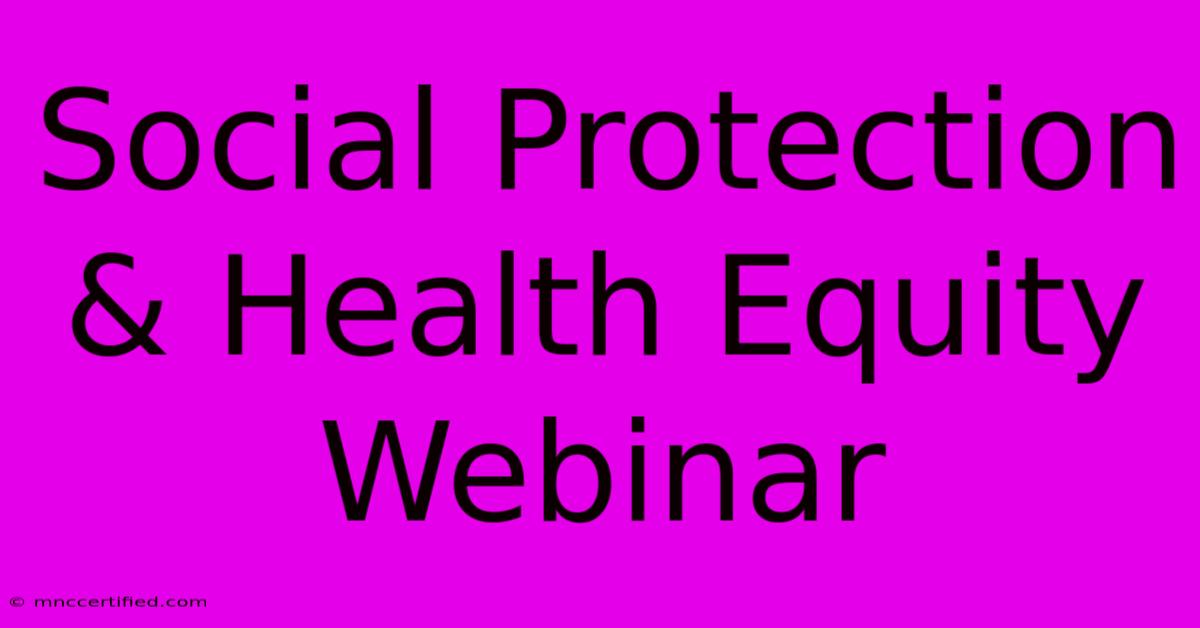Social Protection & Health Equity Webinar

Table of Contents
Social Protection and Health Equity: A Powerful Partnership
This webinar explores the critical intersection of social protection and health equity, examining how robust social safety nets can significantly improve health outcomes and reduce disparities. We'll delve into evidence-based strategies, successful case studies, and policy recommendations to build more equitable and healthier societies.
What is Social Protection? Understanding the Foundation
Social protection encompasses a range of policies and programs designed to reduce poverty and vulnerability by providing basic security to individuals and households. This includes:
- Cash transfers: Direct financial assistance, often conditional upon specific actions like school attendance or healthcare visits. These are crucial for health equity as they directly address financial barriers to healthcare access.
- Food assistance programs: Addressing nutritional needs, a cornerstone of good health. Food insecurity is directly linked to poorer health outcomes, making food assistance programs a vital component of a comprehensive social protection strategy.
- Unemployment benefits: Providing income support during job loss, mitigating the stress and health consequences of unemployment.
- Healthcare financing: Ensuring access to essential health services, regardless of ability to pay. This is absolutely paramount for achieving health equity.
- Social insurance: Protecting against risks like illness, disability, and old age.
These programs form the bedrock of a strong social protection system, essential for achieving wider health equity.
The Link Between Social Protection and Health Outcomes
The evidence is clear: robust social protection significantly improves health outcomes. By reducing financial burdens and providing essential resources, these programs help to:
- Increase access to healthcare: Cash transfers, for example, can directly fund healthcare visits and medication, leading to improved disease management and better health outcomes.
- Improve nutrition and food security: Food assistance reduces malnutrition, a major contributor to child mortality and chronic diseases.
- Reduce stress and improve mental health: Financial security reduces stress, a significant factor in many health problems.
- Promote preventative healthcare: Social protection enables individuals to engage in preventative healthcare measures, like vaccinations and regular check-ups.
Addressing Health Disparities Through Social Protection: The Equity Lens
While social protection programs offer immense potential, their design and implementation must explicitly address existing health disparities. Ignoring equity leads to unequal access and perpetuates existing inequalities. Key considerations include:
- Targeting vulnerable populations: Programs need to reach the most vulnerable, including women, children, older adults, people with disabilities, and marginalized communities. This requires careful targeting and outreach strategies.
- Addressing systemic barriers: Social protection should address systemic barriers like discrimination, lack of access to information, and geographical isolation that disproportionately affect marginalized groups.
- Data-driven policy: Regular monitoring and evaluation are crucial to ensure programs are effectively reaching their intended beneficiaries and achieving health equity goals. This requires the collection and analysis of robust data, disaggregated by relevant demographic factors.
- Community participation: Engaging communities in the design and implementation of programs ensures they are culturally appropriate and responsive to local needs.
Case Studies: Successes and Lessons Learned
This webinar will showcase compelling case studies illustrating the positive impact of well-designed social protection programs on health equity. We'll explore examples from diverse contexts and examine the strategies that contributed to their success. These real-world examples will provide valuable insights into effective implementation.
Moving Forward: Policy Recommendations and Next Steps
This session will culminate with actionable policy recommendations for strengthening the link between social protection and health equity. We'll discuss strategies for:
- Investing in robust social protection systems: Highlighting the economic and social returns of investing in these systems.
- Integrating health considerations into social protection design: Ensuring programs address the specific health needs of target populations.
- Strengthening monitoring and evaluation: Tracking progress towards health equity goals.
- Promoting intersectoral collaboration: Working across sectors to achieve synergistic outcomes.
By attending this webinar, you will gain a deeper understanding of the crucial relationship between social protection and health equity, and acquire practical tools and insights to advocate for and implement policies that promote healthier and more equitable societies. This is crucial for achieving the Sustainable Development Goals, particularly SDG 3 (Good Health and Well-being) and SDG 1 (No Poverty).

Thank you for visiting our website wich cover about Social Protection & Health Equity Webinar. We hope the information provided has been useful to you. Feel free to contact us if you have any questions or need further assistance. See you next time and dont miss to bookmark.
Featured Posts
-
Red Sea Boat Sinks 8 Missing
Nov 27, 2024
-
Insurance For A Clothing Store
Nov 27, 2024
-
Tierney Back In Arsenal Fold
Nov 27, 2024
-
Downing Street Rejects Spy Claims
Nov 27, 2024
-
Landlord Starts Petition New General Needed
Nov 27, 2024